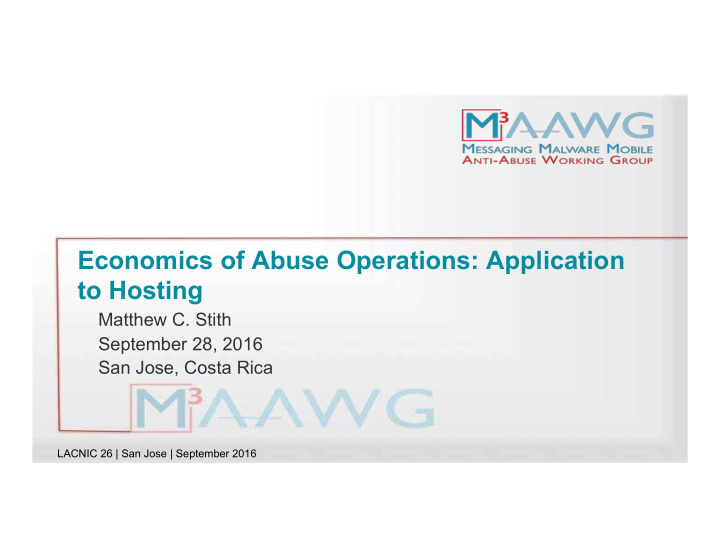



Economics of Abuse Operations: Application to Hosting Matthew C. Stith September 28, 2016 San Jose, Costa Rica LACNIC 26 | San Jose | September 2016
About the presenter • 8 Years at Rackspace • Rackspace’s Acceptable Use Team and Postmaster • Co-Chair of M3AAWG’s Hosting Committee • Member of M3AAWG’s Board of Directors
History of Rackspace Anti-Abuse Teams • The beginning • Lessons learned • Change in the landscape and team • The Future
In the beginning there was spam • Rackspace was founded in 1998 but did not have an Acceptable Use Policy or AUP team until 2000 – Reports that Rackspace was a haven for child exploitation and spammers was published – Law enforcement contacted Rackspace about the existence of child exploitation – Acceptable Use Policy was written and a team formed
More Spam and Buyin from Above • The “Spammer Special” • Skylist (2002) – Rackspace’s first 1 million dollar customer – Was a notorious spammer – Became listed on Spamhaus’ ROSKO list 2003 – An entire new datacenter was all blacklisted • Rackspace leadership made the decision to terminate Skylist • Along with the passage of the CAN-SPAM
A lesson in enforcement • Rackspace received its first Law Enforcement request in 2004 for Indymedia • On the advice of counsel we contacted the FBI and did everything that they said.
It did not go well
It did not go well
The Rise of “THE CLOUD” • Fast forward to 2008 – Kicking spammers off the network – Preventing exploitation on network – Proper processes for customers and the business – Then suddenly … .. The cloud • Within months spam complaints became hacking complaints • Fraud … . So much fraud Poor controls, no limits Customers getting IPs that were already tainted
The future • Data Driven Approaches • Automate • Integration with product organizations
Putting an abuse desk into perspective • Protecting the system – Being on the internet makes your company a target for abuse – No one customer is bigger than the whole system – Pay attention to outliers • Protecting the customer – Users are your weakest point of defense – Customers depend on the service to be up – Deter malicious parties from considering your service – Know about issues with customers before they do
Compromises • Customer services and accounts – Support – Remediation – Downtime of customer/system environments • Customers attacking other customers – Gives the appearance of lack of security – Having to play both sides of the fence (complainer and complainant) • Knowledge of when and how to suspend/terminate
Attacks • Phishing campaigns on customers and employees – Theft of information • Personal • Financial • Company Specific • DDOS – Misconfigurations – Retaliation • Hacking – Brute force – Defaced sites / Malware payloads
Fraud • Impacts profitability – Chargebacks – Revenue loss from usage • Network issues – IP and domain blacklisting – Over utilization of resources • Support overhead – Accounts receivable – Support being abused
Fraud Trends Cloud
Fraud Trends Cloud
Fraud Trends Email
Fraud Trends Email
Industry Expertise and Partnerships • The landscape can change rapidly • Training of staff and customers • Gaining and sharing knowledge – Certifications – Trusted reporters and contacts – Industry specific groups • Faster remediation of issues impacting your network from outside sources
A word on headcount • “I’ll just ask for a team of 20 people to fight all of this!” • Start small aim for what impacts your system the most • Gather data – Customer downtime due to abuse – Loss of revenue – Blacklistings – Compromises/Fraud – Overall complaints and type • Grow organically – Know what kind of worker you are looking for – Sometimes head count isn’t the answer
Recommend
More recommend